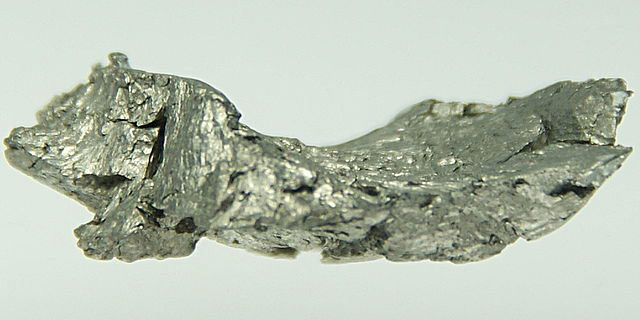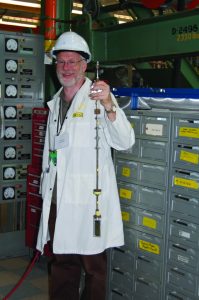
Researchers from McGill University accessed the CNBC to prove that yes, you can do neutron scattering on gadolinium compounds, and have attracted international collaborators as a result.
Source: Canadian Neutron Beam Centre (CNBC)
Contact: cnbc@cnl.ca
Image: Gadolinium
Neutron beams are powerful tools for studying a great range of materials, from biological to industrial, to materials of fundamental interest for physicists. Yet there is a class of materials that many researchers often consider impossible to study with neutron diffraction because they contain elements that absorb neutrons strongly rather than scatter them.
Prof. Dominic Ryan of McGill University has accessed the CNBC to do the impossible, and as a result, has built up a large network of international collaborators from the United States and Europe to investigate materials that have applications in data storage and magnetic cooling and that contain these neutron-absorbing elements.

Prof. Ryan proudly displays his flat-plate sample holder for neutron scattering on gadolinium compounds at the CNBC
Gadolinium has the highest tendency to absorb neutrons of all the elements: nearly ten times higher than samarium, which is the second highest, and about 10,000 times higher than metals like iron and copper, which are commonly examined with neutron diffraction. Yet, Ryan worked with CNBC staff to develop a means to conduct powder neutron diffraction on silicon-doped gadolinium- germanium alloys like Gd5Si2Ge2, which has a very large giant magnetocaloric effect. In magnetocaloric materials, the temperature can be greatly changed by controlling a magnetic field around it, a property that can be used for efficient refrigeration.
While other researchers had discovered complex magnetic and structural ordering in these alloys, a full investigation was stymied by an inability to use neutron diffraction to solve the structures. Ryan overcame the difficulties by developing a low background, flat-plate sample holder, spreading a very thin layer of the powdered alloy over the plate to use the full area of the neutron beam, and collecting data for long periods. The experiments proved that the impossible could be done and solved key aspects of the magnetic and structural ordering of these alloys. These experiments have been extended to several other materials, including new iron-based, high-temperature superconductors and GdCo12-xFexB6, which showed that alternative methods previously used to characterise these materials indirectly gave inaccurate results.
Researchers around the world, who previously believed they could not use neutron beams to study their highly absorbing materials, now call Prof. Ryan, who can get it done using the CNBC.
